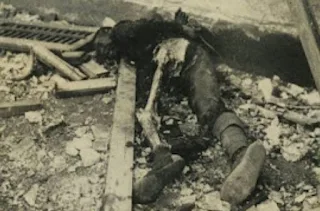Brutality Moment During The Grisly Chichijima Incident of 1944, Japanese Troops Butchered Four American Soldiers ate Their Livers
During the grisly Chichijima incident of 1944, Japanese troops butchered four American soldiers and ate their livers, which they pierced with bamboo sticks and cooked with soy sauce and vegetable
In 1945, a first-year medical student named Toshio Tono stood in the halls of Kyushu Imperial University as two blindfolded American prisoners were led into a pathology lab by Japanese soldiers.
“I did wonder if something unpleasant was going to happen to them, but I had no idea it was going to be that awful,” Tono told The Guardian in 2015.
The two blindfolded men were members of a B-29 bomber team and they were already wounded after being captured. They were apparently led to believe that they’d be receiving treatment for their injuries.
Instead, the doctors began a series of human experiments as Tono looked on in horror.
According to testimony later used against the doctors at the Allied War Crimes Tribunals, they injected one prisoner with seawater to see if it could be a substitute for a sterile saline solution.
Other prisoners had parts of their organs removed, with one deprived of a whole lung just so the doctors could see how his respiratory system would respond.
As a young medical student, Tono’s tasks usually involved washing blood off the floor and preparing seawater drips for his superiors.
He said, “The experiments had absolutely no medical merit. They were being used to inflict as cruel a death as possible on the prisoners.”
But as horrifying as these experiments were, one allegation was perhaps the worst: cannibalism. According to American lawyers, at least one prisoner’s liver had been removed, cooked, and served to Japanese officers.
Though charges of cannibalism were later dropped in this specific case, there’s no question that some Japanese soldiers ate human flesh during World War II. And sometimes, they weren’t even hungry when they did it.
For some World War II survivors, exposing the truth about Japanese war crimes — such as cannibalism — became an obsession.
One such survivor was Kenzo Okuzaki, an Imperial Japanese Army veteran and the subject of the 1988 documentary The Emperor’s Naked Army Marches On.
By the time Okuzaki shot this film, he had an extensive criminal record. He had already spent 10 years in solitary confinement for manslaughter in the 1950s.
And shortly after getting out of prison, he had staged a bizarre demonstration at the Imperial Palace in 1969.
Firing pachinko pinballs from a slingshot aimed at Emperor Hirohito — the same emperor who had reigned during World War II — Okuzaki shouted to the ghost of a former war comrade.
He yelled, “Yamazaki, shoot the emperor with a pistol!” He then turned himself in to the authorities.
As it turned out, Okuzaki took this strange action in order to pursue the emperor’s war responsibility in the Japanese court system.
During his trial, he challenged the constitutionality of the emperor system and argued that the emperor was responsible for Japan’s war crimes during World War II.
Although Okuzaki’s argument was ultimately ignored, this may have been the sole instance in modern Japanese history where these questions were seriously discussed in a legal setting.
He was detained for one year and 10 months, including two months in a psychiatric hospital.
The Emperor’s Naked Army Marches On focuses on Okuzaki’s continuing one-man crusade in the 1980s to expose the truth about the war — and to find out what really happened to his fellow comrades.
Thanks for reading leave your thoughts in the comments section below
Read more on our Rare History Channel












Comments
Post a Comment